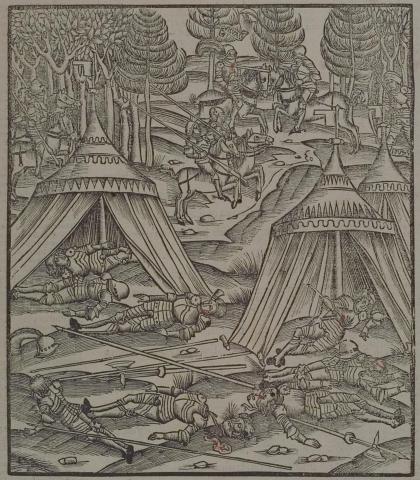Annotations
In the foreground, several men lie dead in the Rutulian camp, as a result of the massacre by Nisus and Euryalus (314-366). Behind the tents, to the left, horsemen coming from Latinus's city (367-70) see Euryalus with his shiny helmet leaving the scene of the massacre (371-4). In the top center, the Latins have chased the two Trojans into the woods, where the pair has become separated (377-93). A Rutulian soldier kills Euryalus with a spear (394-8; 422-4, 431-7) as Nisus enters the scene from the very right edge of the image (394-401).
Woodcut illustration from the “Strasbourg Vergil,” edited by Sebastian Brant: Publii Virgilii Maronis Opera cum quinque vulgatis commentariis expolitissimisque figuris atque imaginibus nuper per Sebastianum Brant superadditis (Strasbourg: Johannis Grieninger, 1502), fol. 337r, executed by an anonymous engraver under the direction of Brant.


Sebastian Brant (1458-1521) was a humanist scholar of many competencies. Trained in classics and law at the University of Basel, Brant later lectured in jurisprudence there and practiced law in his native city of Strasbourg. While his satirical poem Das Narrenschiff won him considerable standing as a writer, his role in the transmission of Virgil to the Renaissance was at least as important. In 1502 he and Strasbourg printer Johannes Grüninger produced a major edition of Virgil’s works, along with Donatus’ Life and the commentaries of Servius, Landino, and Calderini, with more than two hundred woodcut illustrations. (Annabel Patterson)